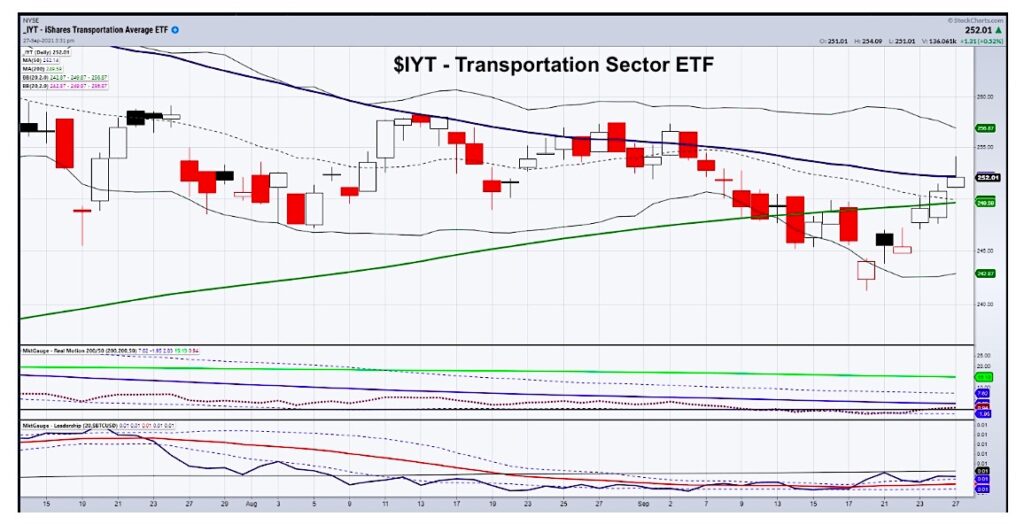The key sector to reflect optimism/pessimism about consumers, industrial demand, supply chain issues and the upcoming budget proposals is Transportation and the trading ETF (IYT).
The Retail sector improved to start the week. As measured by XRT, we see an improved phase back to bullish, but still a very much rangebound sector.
We saw more rotation into the small caps, although IWM is also looking very much rangebound.
Regional Banks KRE were quite happy, and perhaps the rise in yields has helped that area.
However, the Transportation Sector (IYT) continues to intrigue us the most. IYT, at the end of the day, could not clear over the 50-day moving average nor the very important 6-month calendar range.

Is this telling of the many fractures we see both economically and politically?
On the table right now is the $3.5 trillion budget reconciliation package, recognized as the centerpiece of President Joe Biden’s domestic agenda. This is a ten-year spending plan designed to address education, health care, and childcare support needs.
It also includes a package to tackle climate change and infrastructure.
However, with 10 moderate Democrats on the fence there is high potential for a stalemate, with questions on taxes, health, climate change and the ultimate price tag.
Centrist Democrats see the overall price tag as too much, while progressive lawmakers are hesitant to compromise any further after already having dropped even more ambitious ideas.
Furthermore, most if not all Republicans will likely veto it.
Additionally, a $1 trillion infrastructure bill will be sent to the House floor next week. That bill includes funding for roads and bridges, money for transit and rail, a broadband upgrade and an upgrade for airports, ports and waterways. All are considered essential upgrades to the U.S.’s flailing infrastructure.
And that’s not all!
The Fiscal year ends on Thursday. The government needs to come to some sort of agreement before then or risk a government shutdown. However, projections still have the Treasury being able to exercise its borrowing authority through October 15 or November 4th depending on how long current allocations last.
Even without Biden’s budget package, good news could at least come in the form of an agreement to pay off old debts, requiring the debt ceiling to be raised marginally. The bad news would be that raising the debt ceiling to include the budget proposal has little chance of passing the Senate.
So, the government could prevent a shutdown, or worse a default, but without passing the budget proposal, the confidence in the current administration will suffer further.
Bottom line for the market, we see the rates continuing to rise, or at least we venture to say rates have bottomed.
Without a package for infrastructure or engendering growth, we still see a stagflation cycle. We expect an ensuing commodities super cycle, hence raw material shortages, supply chain issues, and a low labor market. A hoarding mentality will prevail.
Clearly, our dear Transportation sector sees this conundrum. How will the US and Central Banks roll back the easy money, taper the bond buying program, and raise rates enough to control inflation without collapsing a fragile system?
If it can be pulled off, we will see it in IYT. If it cannot be pulled off, we will see it in IYT!
Stock Market ETFs Trading Analysis and Summary:
S&P 500 (SPY) Recorded an inside day under the 50-day moving average.
Russell 2000 (IWM) 228 is resistance and 221-22 is must hold support.
Dow Jones Industrials (DIA) Also stopped short of clearing the 50-day moving average.
Nasdaq (QQQ) Trading back under the 50-day moving average.
KRE (Regional Banks) The winner today- 66.35 is support and 70 is resistance.
SMH (Semiconductors) 267 must hold and 272.50 is a level it must clear.
IYT (Transportation) 252.10 the 50-day moving average with 250 being pivotal support.
IBB (Biotechnology) Broke the 50-day moving average and now will test support.
XRT (Retail) 92-98 is rangebound area.
Twitter: @marketminute
The author may have a position in mentioned securities at the time of publication. Any opinions expressed herein are solely those of the author and do not represent the views or opinions of any other person or entity.








